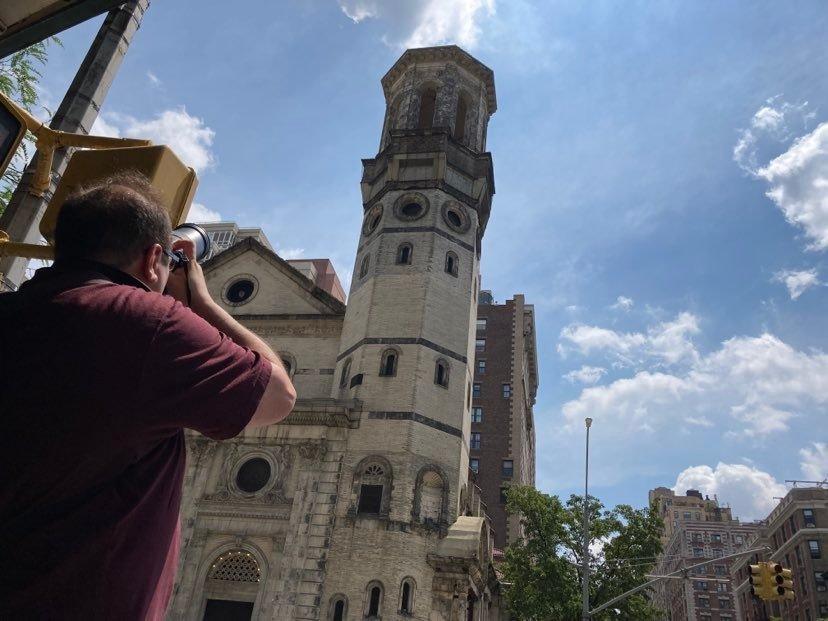Nestled atop the southwest tower of St. Paul & St. Andrew United Methodist Church (86th and West End Ave) reside New York City’s most fearsome predators. Clocking in at over 200 mph, these carnivores are the fastest creatures on earth and can leave behind a wake of grisly devastation. Craving a glimpse into the life of our new neighbors, Upper West Siders are readying their cameras and binoculars, aiming them into the sky toward a new family of peregrine falcons.
On Monday, nature photographer Jonathan Levitt stood at the corner of 86th and West End. His Instagram captures a young peregrine falcon that spread its wings, having just leapt from its perch, with only thin air beneath it. “I stood at the corner for about 45 minutes before I heard the falcons screaming at each other,” he writes. “After some time I managed to catch them all flying out. Feel so blessed to have caught this with my camera.”
Advertisement
In 1962, Rachel Carson’s revolutionary book Silent Spring was released and inspired the modern environmental movement. Carson argued that unintended consequences would follow our decision to irresponsibly treat crops and plants with pesticides and other chemicals. Her book would influence the subsequent ban of DDT, which at the time was a very common (and celebrated) pesticide. DDT was an insecticide sprayed on crops. Songbirds fed on those crops and peregrine falcons consumed those songbirds. While not potent enough to kill an adult peregrine falcon, the digested pesticides made falcon eggshells soft. While brooding (sitting on eggs), the shells would crush under their parent’s weight. By the early 1970’s, nearly 90% of the peregrine falcon population had vanished from the United States.
In 1972, eight years following Carson’s death, DDT was outlawed. Two years later, a team of scientists and researchers from Cornell University gathered peregrine falcons from around the world, painstakingly bred a small number in captivity and released them in upstate New York. By 1999, the population had flourished enough to be removed from the federal list of endangered species (they continue to remain on the New York Endangered Species list). Those birds who had evolved to live on upstate cliffs migrated south to some of the highest peaks they could find: New York City skyscrapers and bridges. As The Smithsonian Magazine put it, “Immigrant birds had come to the city of immigrants.”
When one arrives in New York City, one must acquire a job. Thankfully, Eric Balcanoff, an NYC nature photographer, was around to document this important process. “Urban Wildlife at its finest,” he tweets, “featuring the Upper West Side’s newest and fastest traffic cop.”
Advertisement
Nearly 50 of these falcon pairs are New York State residents. They mate for life, carve nests into cliffs and sky scrapers, and migrate over 15,000 miles — only to return to the same nest. Often hunting together, their sharp eyesight and ability to dive at extraordinary speeds helps them take down prey; eight razor sharp talons are nice, but being able to tackle prey at 242 miles per hour is also a helpful attribute.
Of course, some are ferocious, and some are just learning. Eagle-eyed Eric Balcanoff seems to have found the latter, spotting a fledgling falcon perched on top of a street light and tweeting, “When you’re trying to be fierce but just learning how to falcon.”
The peregrine falcon’s story is one of survival; a dramatic comeback tale starring a remarkable animal whose life is often hidden in the clouds. I walked down the street to 86th and West End to see if I could grab a quick picture for this article. I came across Jonathan Levitt at the corner, steadily aiming his long camera lens toward the nesting family high up above our heads. After a moment he gently moved his camera off to the side. He looked back down to earth, fulfillment washing over him, as he smiled and said, “it’s amazing, isn’t it?”




One of them landed right outside my son’s window on Sunday and was there for about an hour – I’ve got pics!!!
I wonder if these are the same ones that frequent St. John the Divine?
Now we need roughly 1000 more of these fine feathered friends to help even the playing field with our friendly rat population. 1000 falcon release program, anyone?